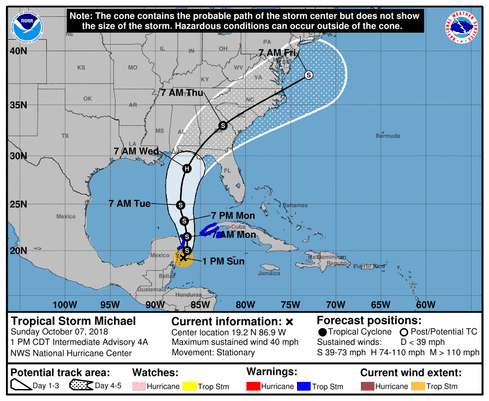The 2018 hurricane season isn't over yet.
Tropical Storm Michael formed Sunday morning in the Caribbean Sea and is forecast to strengthen into a hurricane over the next couple of days, the National Hurricane Center said.
It's predicted to head straight for the northeastern Gulf Coast, probably making landfall as Category 2 Hurricane Michael on Wednesday, the hurricane center said.
As of 11 p.m. EDT, the storm had winds of 60 mph and was about 105 miles east-southeast of Cozumel, Mexico. It was moving to the north at 5 mph.
"Heavy rainfall, wind and storm surge impacts will be possible across portions of the northern Gulf Coast by midweek," according to the hurricane center.
Before that, seas will build across the gulf early this week as the storm churns northward, creating dangers for swimmers and boaters well ahead of the storm, AccuWeather warned.
Florida Gov. Rick Scott said Sunday that he planned to declare a state of emergency for counties in the Florida Panhandle and the Big Bend area of the state. The declaration would free up resources for storm preparation.
“As we continue to monitor this storm’s northward path toward Florida, it is critically important that our communities have every available resource to keep everyone safe and prepared,” Scott said in a statement.
After the storm moves inland, it could dump additional unwanted rain on the Carolinas, which were battered by Florence in September. "Areas hit hard by Florence may face disruptions to ongoing cleanup efforts or renewed flooding depending on the track of the storm," AccuWeather senior meteorologist Kristina Pydynowski said.
Tropical storm warnings were posted for western Cuba and Mexico's northeast Yucatan Peninsula, including Cancun, weather.com reported.
Up to a foot of rain is possible in western Cuba, which could "lead to life-threatening flash floods and mudslides in areas of mountainous terrain," the hurricane center warned.
Michael is the 13th named tropical storm or hurricane of the 2018 Atlantic hurricane season.
